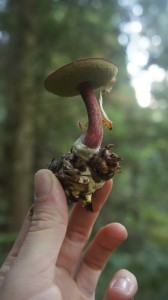I have always been intrigued by fungi. Their extreme diversity from edible to deadly poisonous and the almost endless configurations of colours, shapes and habitats make fungi truly bizarre. Fungi are immensely important in both the visible, and invisible aspects of our daily lives. From the decomposition of organic matter in soils and the cycling of carbon in ecosystems, to the production of items we use every day (beer, wine, soy sauce, antibiotics….), the lives of humans are inescapably linked to fungi.
The mushroom is likely the most recognizable aspect of a fungus. It is a fascinating fruiting body that has evolved over hundreds of millions of years. The intricacy of spore dispersal some mushrooms employ is bewildering. For example, mushrooms in the genus Agaricales, Boletales, and Polyperales are able to sense their position in space, and grow so their caps are perpendicular to the ground. This maximizes the number of spores that will land on the soil beneath, rather than on the mushroom itself. Another characteristic in these genus of fungi is the method in which they “shoot” their spores. These basidiospores (spores that are forcibly discharged) grow on narrow stalks on the gills or pores of the mushroom. When the spore is mature, water condenses on sugars secreted at the base and top of the spore. When the droplet becomes too large for surface tension to hold it in place, the two droplets rush together, releasing enough energy to break the spore from the stalk and away from the gills.
Another fascinating aspect of fungi is that most species reproduce both sexually and asexually. Whether a fungi requires a mate or not depends on life stage and environmental conditions. For example, Saccharomyces cerivisea the fungi responsible for fermentation, only produces ethanol as a byproduct when it is undergoing sexual reproduction, initiated by a lack of oxygen. The sexual spores of some fungi can even communicate with each other in order to fuse and mate. They release a series of “transmission” and “receiving” pheromones that direct the growing hyphae towards each other.
All-in-all, fungi are extremely complex, and much about them is still not known, or misunderstood. Their ability to evolve and acquire unique adaptations to their environments will continue to interest and confuse researchers, likely indefinitely.
Tags: No Comments


0 responses so far ↓
There are no comments yet...Kick things off by filling out the form below.